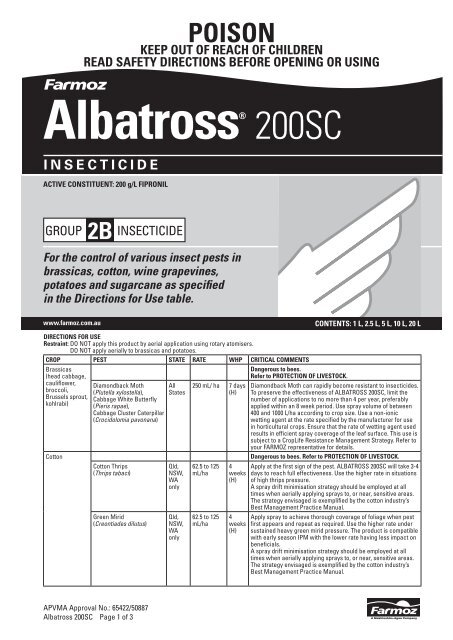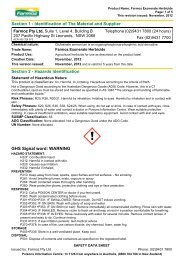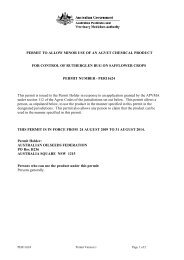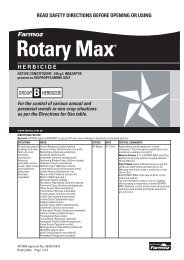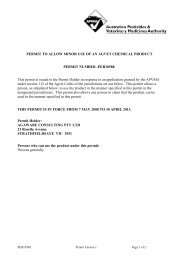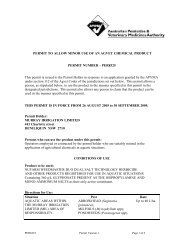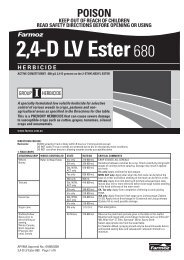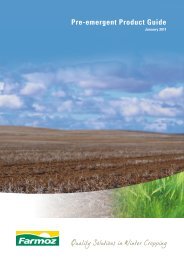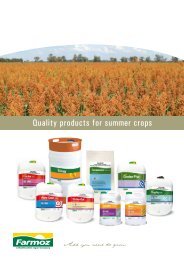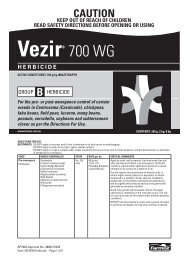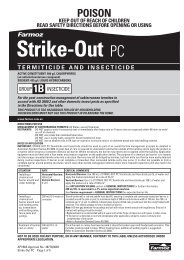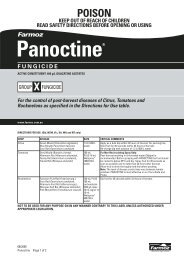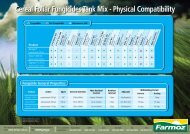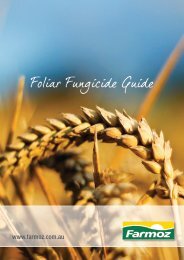Label - Farmoz
Label - Farmoz
Label - Farmoz
Create successful ePaper yourself
Turn your PDF publications into a flip-book with our unique Google optimized e-Paper software.
POISON<br />
KEEP OUT OF REACH OF CHILDREN<br />
READ SAFETY DIRECTIONS BEFORE OPENING OR USING<br />
Albatross®<br />
INSECTICIDE<br />
ACTIVE CONSTITUENT: 200 g/L FIPRONIL<br />
GROUP<br />
2B INSECTICIDE<br />
For the control of various insect pests in<br />
brassicas, cotton, wine grapevines,<br />
potatoes and sugarcane as specified<br />
in the Directions for Use table.<br />
APVMA Approval No.: 65422/50887<br />
Albatross 200SC Page 1 of 3<br />
200SC<br />
www.farmoz.com.au CONTENTS: 1 L, 2.5 L, 5 L, 10 L, 20 L<br />
DIRECTIONS FOR USE<br />
Restraint: DO NOT apply this product by aerial application using rotary atomisers.<br />
DO NOT apply aerially to brassicas and potatoes.<br />
CROP PEST STATE RATE WHP CRITICAL COMMENTS<br />
Brassicas<br />
(head cabbage,<br />
cauliflower,<br />
broccoli,<br />
Brussels sprout,<br />
kohlrabi)<br />
Diamondback Moth<br />
(Plutella xylostella),<br />
Cabbage White Butterfly<br />
(Pieris rapae),<br />
Cabbage Cluster Caterpillar<br />
(Crocidolomia pavonana)<br />
All<br />
States<br />
250 mL/ ha 7 days<br />
(H)<br />
Dangerous to bees.<br />
Refer to PROTECTION OF LIVESTOCK.<br />
Diamondback Moth can rapidly become resistant to insecticides.<br />
To preserve the effectiveness of ALBATROSS 200SC, limit the<br />
number of applications to no more than 4 per year, preferably<br />
applied within an 8 week period. Use spray volume of between<br />
400 and 1000 L/ha according to crop size. Use a non-ionic<br />
wetting agent at the rate specified by the manufacturer for use<br />
in horticultural crops. Ensure that the rate of wetting agent used<br />
results in efficient spray coverage of the leaf surface. This use is<br />
subject to a CropLife Resistance Management Strategy. Refer to<br />
your FARMOZ representative for details.<br />
Cotton Dangerous to bees. Refer to PROTECTION OF LIVESTOCK.<br />
Cotton Thrips<br />
(Thrips tabaci)<br />
Green Mirid<br />
(Creontiades dilutus)<br />
Qld,<br />
NSW,<br />
WA<br />
only<br />
Qld,<br />
NSW,<br />
WA<br />
only<br />
62.5 to 125<br />
mL/ha<br />
62.5 to 125<br />
mL/ha<br />
4<br />
weeks<br />
(H)<br />
4<br />
weeks<br />
(H)<br />
Apply at the first sign of the pest. ALBATROSS 200SC will take 3-4<br />
days to reach full effectiveness. Use the higher rate in situations<br />
of high thrips pressure.<br />
A spray drift minimisation strategy should be employed at all<br />
times when aerially applying sprays to, or near, sensitive areas.<br />
The strategy envisaged is exemplified by the cotton industry’s<br />
Best Management Practice Manual.<br />
Apply spray to achieve thorough coverage of foliage when pest<br />
first appears and repeat as required. Use the higher rate under<br />
sustained heavy green mirid pressure. The product is compatible<br />
with early season IPM with the lower rate having less impact on<br />
beneficials.<br />
A spray drift minimisation strategy should be employed at all<br />
times when aerially applying sprays to, or near, sensitive areas.<br />
The strategy envisaged is exemplified by the cotton industry’s<br />
Best Management Practice Manual.
CROP PEST STATE RATE WHP CRITICAL COMMENTS<br />
Potatoes Wireworm (various),<br />
Mole Cricket (various)<br />
Wine<br />
Grapevines<br />
Whitefringed Weevil<br />
(Naupactus leucoloma)<br />
Fig Longicorn<br />
(Acalolepta vastator)<br />
APVMA Approval No.: 65422/50887<br />
Albatross 200SC Page 2 of 3<br />
All<br />
States<br />
250 mL/ha – Apply as a broadcast spray to the surface of the soil and<br />
incorporate to a depth of 15 cm prior to planting.<br />
500 mL/ha<br />
100 mL/100 L – Apply as a single spray to dormant vines following pruning and<br />
prior to budburst. Apply only as a high volume spray using hand<br />
held equipment. Thorough coverage of vine trunks and cordons<br />
is essential for effective control.<br />
Refer to Application Wine grapevines.<br />
Sugarcane Dangerous to bees. Refer to PROTECTION OF LIVESTOCK.<br />
Sugarcane Weevil Borer<br />
(Rhabdoscelus obscurus)<br />
Sugarcane Wireworm<br />
(various)<br />
Qld,<br />
NSW,<br />
WA,<br />
NT<br />
only<br />
2 to 5.7<br />
mL/100 m<br />
row<br />
Single row<br />
plantings:<br />
1.1 mL/100<br />
m single<br />
row length<br />
Double row<br />
plantings:<br />
1.8 mL/100<br />
m double<br />
row length<br />
12<br />
weeks<br />
(H, G)<br />
Apply during the Summer months of December to February when<br />
the crop has produced the first millable internode of cane. Use<br />
hollow cone nozzles as a directed spray to cover the base of the<br />
sugarcane stools and up the stalk to a height of 40 cm. Treat both<br />
sides of the stools ensuring coverage of all stalks, soil and trash<br />
in an area to 10 cm either side of the stools. Use a non-ionic<br />
wetting agent at the rate specified by the manufacturer. Ensure<br />
that the rate of wetting agent used results in efficient spray<br />
coverage of the stalk, soil and trash surface.<br />
Apply in a minimum water volume of 250 L/ha (approx. 3.8 L/100 m<br />
row). Use the higher rate when pest pressure is heavy.<br />
– Apply in the planting furrow over the top of the plant pieces<br />
(setts), in sufficient water to ensure coverage of the plant pieces<br />
and the surrounding soil.<br />
NOT TO BE USED FOR ANY PURPOSE OR IN ANY MANNER CONTRARY TO THIS LABEL UNLESS AUTHORISED UNDER<br />
APPROPRIATE LEGISLATION.<br />
WITHHOLDING PERIODS:<br />
(H) = Harvest, (G) = Grazing<br />
BRASSICAS: DO NOT HARVEST FOR 7 DAYS AFTER APPLICATION.<br />
COTTON: DO NOT HARVEST FOR 4 WEEKS AFTER APPLICATION.<br />
DO NOT GRAZE OR CUT FOR STOCK FOOD.<br />
WINE GRAPEVINES: NOT REQUIRED WHEN USED AS DIRECTED (H).<br />
DO NOT FEED TRASH OR BY-PRODUCTS RESULTING FROM TREATED GRAPEVINES TO LIVESTOCK (G).<br />
POTATOES: NOT REQUIRED WHEN USED AS DIRECTED.<br />
DO NOT GRAZE OR CUT FOR STOCK FOOD ANY PART OF FAILED CROP (INCLUDING TUBERS).<br />
SUGARCANE: DO NOT HARVEST FOR 12 WEEKS AFTER APPLICATION.<br />
DO NOT GRAZE OR CUT FOR STOCK FOOD FOR 12 WEEKS AFTER APPLICATION.<br />
LIVESTOCK WITHHOLDING PERIOD:<br />
WITHHOLD STOCK FROM SLAUGHTER FOR 21 DAYS AFTER APPLICATION, WHERE STOCK WERE PRESENT IN CROP OR PASTURE AT TIME OF<br />
APPLICATION.<br />
GENERAL INSTRUCTIONS<br />
INSECTICIDE RESISTANCE WARNING<br />
For insecticide resistance<br />
management FARMOZ ALBATROSS ®<br />
2B INSECTICIDE<br />
GROUP<br />
200SC Insecticide is a Group 2B insecticide. Some naturally occurring<br />
insect biotypes resistant to ALBATROSS 200SC and other Group 2B<br />
insecticides may exist through normal genetic variability in any insect<br />
population. The resistant individuals can eventually dominate the insect<br />
population if ALBATROSS 200SC or other Group 2B insecticides are<br />
used repeatedly. The effectiveness of ALBATROSS 200SC on resistant<br />
individuals could be significantly reduced.<br />
Since the occurrence of resistant individuals is difficult to detect prior<br />
to use, FARMOZ Pty. Ltd. accepts no liability for any losses that may<br />
result from the failure of this product to control resistant insects.<br />
ALBATROSS 200SC may be subject to specific resistance management<br />
strategies. Consult a FARMOZ representative for further information if<br />
required.<br />
RESIDUES MANAGEMENT IN EXPORT PRODUCE<br />
Crops:<br />
Growers should note that MRLs or import tolerances do not exist in all<br />
markets for produce treated with ALBATROSS 200SC.<br />
If you are growing produce for export, please check with FARMOZ Pty.<br />
Ltd. for the latest information on MRLs and import tolerances BEFORE<br />
using ALBATROSS 200SC.<br />
Livestock:<br />
Livestock may be exposed to fipronil residues in the feed by grazing<br />
treated forage and fodder. Observance of the 14 day grazing withholding<br />
period permits compliance with Australian MRLs for fipronil in meat,<br />
offal and milk. To meet more stringent export residues requirements,<br />
Meat and Livestock Australia recommends Export Slaughter Intervals<br />
(ESIs) and Export Grazing Intervals (EGIs) for ALBATROSS 200SC. When<br />
livestock grown for export are grazed on forage and fodder treated with<br />
ALBATROSS 200SC the user must obtain details of the recommended<br />
export intervals from Meat and Livestock Australia and must follow<br />
those recommendations.<br />
MIXING<br />
Brassicas, Cotton, Wine Grapevines, Potatoes, Sugarcane<br />
Slowly add the required amount of product to water in the spray tank<br />
while stirring or agitating. Agitate while spraying. When container<br />
empty, rinse the container with water and add the rinsings to the spray<br />
tank.<br />
APPLICATION<br />
Brassicas: Ensure thorough coverage of foliage and heads.<br />
Cotton: For ground application use a prepared spray volume of 35-75 L/<br />
ha depending on the size of the crop. For aerial application see ‘Aerial<br />
application’ instructions below.
Wine Grapevines: ALBATROSS 200SC should be applied by hand held<br />
equipment as a high volume directed spray of approximately 500 mL of<br />
solution per vine.<br />
AERIAL APPLICATION<br />
Use spray techniques that minimise off-target spray drift. DO NOT use<br />
rotary atomisers. Use application volumes between 20 L and 50 L/ha.<br />
Achieve a droplet density of ~60 droplets/cm 2 on a flat surface on the<br />
target. When spraying large droplets (>250 µm), increase the application<br />
volume to >40 L/ha to ensure sufficient droplets are produced. DO NOT<br />
apply aerially to to brassicas and potatoes.<br />
PRECAUTIONS<br />
Re-entry period: Unless otherwise specified, DO NOT enter treated<br />
areas until the spray has dried, unless wearing cotton overalls buttoned<br />
to the neck and wrist over normal clothing and chemical resistant<br />
gloves. Clothing must be laundered after each days use.<br />
Note: It is the responsibility of the professional operator to ensure that<br />
public entry to treated areas is restricted for the appropriate interval<br />
post application.<br />
Human flaggers, if used in aerial spraying operations, must be protected<br />
by enclosed cabs.<br />
PROTECTION OF CROPS, NATIVE AND OTHER NON-TARGET PLANTS<br />
DO NOT apply in weather conditions or from spraying equipment, that<br />
may cause spray to drift onto non-target plants/crops, cropping lands<br />
or pastures.<br />
PROTECTION OF LIVESTOCK<br />
Dangerous to bees. DO NOT apply where bees from managed hives are<br />
known to be foraging, and crops, weeds or cover crops are in flower at<br />
the time of spraying, or are expected to flower within 28 days. Before<br />
spraying, notify beekeepers to move hives to a safe location with an<br />
untreated source of nectar, if there is potential for managed bees to<br />
be affected by the spray or spray drift. If an area has been sprayed<br />
inadvertently, in which the crop, weeds or cover crop were in flower<br />
or subsequently came into flower, notify beekeepers in order to keep<br />
managed bees out of the area for at least 28 days from the time of<br />
spraying.<br />
Where the owner of managed hives in the vicinity of a crop to be<br />
sprayed is not known, contact your State Department of Primary<br />
Industries/Agriculture, citing the registration number, for assistance in<br />
contacting the owner.<br />
PROTECTION OF WILDLIFE, FISH, CRUSTACEANS AND ENVIRONMENT<br />
DO NOT contaminate streams, rivers or waterways with the chemical<br />
or used containers. DO NOT spray across open bodies of water. Highly<br />
toxic to fish and aquatic organisms. This product will kill susceptible<br />
non-target invertebrates, including beneficial species, if they are<br />
exposed to drift. DO NOT apply aerially to brassicas and potatoes.<br />
A spray drift minimisation strategy should be employed at all times<br />
when aerially applying sprays to, or near, sensitive areas. The strategy<br />
envisaged is exemplified by the cotton industry’s Best Management<br />
Practice Manual.<br />
APVMA Approval No.: 65422/50887<br />
Albatross 200SC Page 3 of 3<br />
STORAGE AND DISPOSAL<br />
Store in the closed, original container in a well-ventilated area as cool<br />
as possible, out of direct sunlight. This container can be recycled if it<br />
is clean, dry, free of visible residues and has the drumMUSTER logo<br />
visible. Triple or pressure rinse container for disposal. Add rinsings to<br />
spray tank. Dispose of the rinsate by adding it to the spray tank.<br />
DO NOT dispose of undiluted chemicals on-site. Wash outside of the<br />
container and the cap. Store cleaned container in a sheltered place<br />
with cap removed. It will then be acceptable for recycling at any<br />
drumMUSTER collection or similar container management program<br />
site. The cap should not be replaced but may be taken separately.<br />
If not recycling, break, crush, or puncture and deliver empty packaging<br />
for appropriate disposal to an approved waste management facility. If<br />
an approved waste management facility is not available bury the empty<br />
packaging 500 mm below the surface in a disposal pit specifically set<br />
up for this purpose clear of waterways, desirable vegetation and tree<br />
roots, in compliance with relevant Local, State or Territory government<br />
regulations. DO NOT burn empty containers or product.<br />
SAFETY DIRECTIONS<br />
Harmful if inhaled or swallowed. DO NOT inhale vapour or spray mist.<br />
When opening the container and preparing spray, wear cotton overalls<br />
buttoned to the neck and wrist, washable hat, elbow-length gloves,<br />
half face-piece respirator with organic/gas cartridge or canister.<br />
When using the prepared spray wear cotton overalls buttoned to the<br />
neck and wrist (or equivalent clothing) and elbow-length chemicalresistant<br />
gloves. After use and before eating, drinking or smoking, wash<br />
hands, arms and face thoroughly with soap and water. After each days<br />
use, wash gloves, face shield or goggles, contaminated clothing and<br />
respirator and if rubber wash with detergent and warm water.<br />
FIRST AID<br />
If poisoning occurs, contact a doctor or Poisons Information Centre.<br />
Phone Australia 131126.<br />
MATERIAL SAFETY DATA SHEET<br />
Additional information is listed in the material safety data sheet (MSDS).<br />
A material safety data sheet for ALBATROSS 200SC is available from<br />
FARMOZ on request. Call Customer Service on (02) 9431 7800.<br />
CONDITIONS OF SALE: The use of FARMOZ ALBATROSS 200SC<br />
Insecticide being beyond the control of the manufacturer, no warranty<br />
expressed or implied is given by FARMOZ Pty. Ltd., regarding its<br />
suitability, fitness or efficiency for any purpose for which it is used by the<br />
buyer, whether in accordance with the directions or not and FARMOZ<br />
Pty. Ltd. accepts no responsibility for any consequence whatsoever<br />
resulting from the use of this product.<br />
® Registered trademark of a Makhteshim-Agan Company<br />
NOT A DANGEROUS GOOD ACCORDING TO THE<br />
AUSTRALIAN DANGEROUS GOODS (ADG) CODE.


